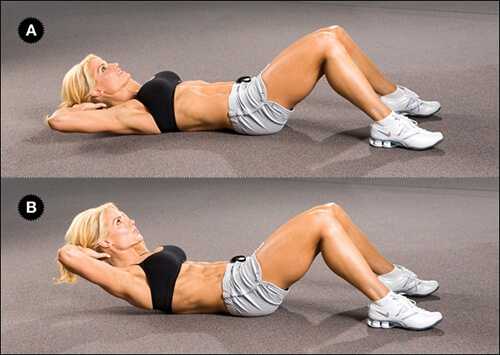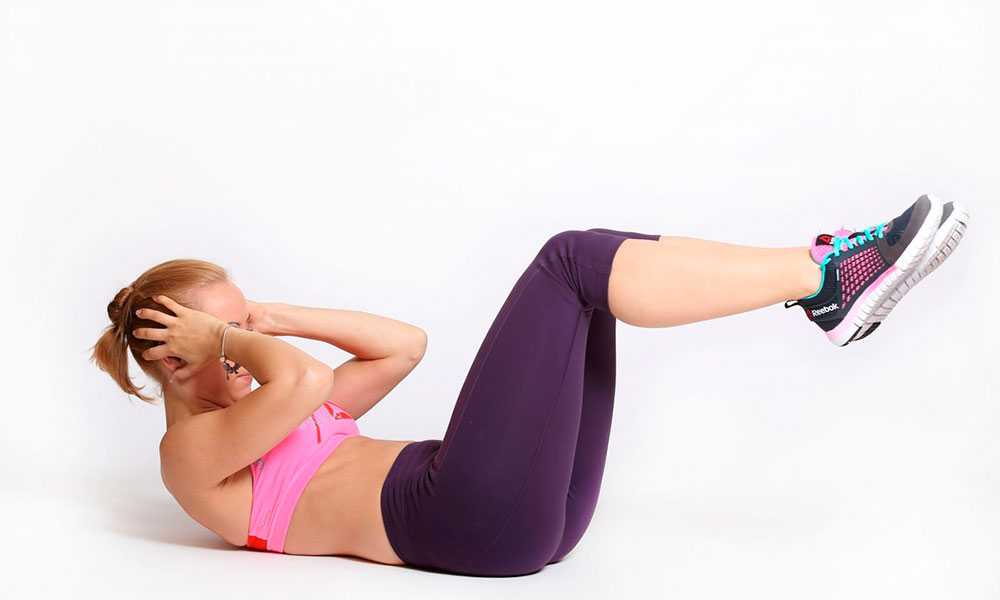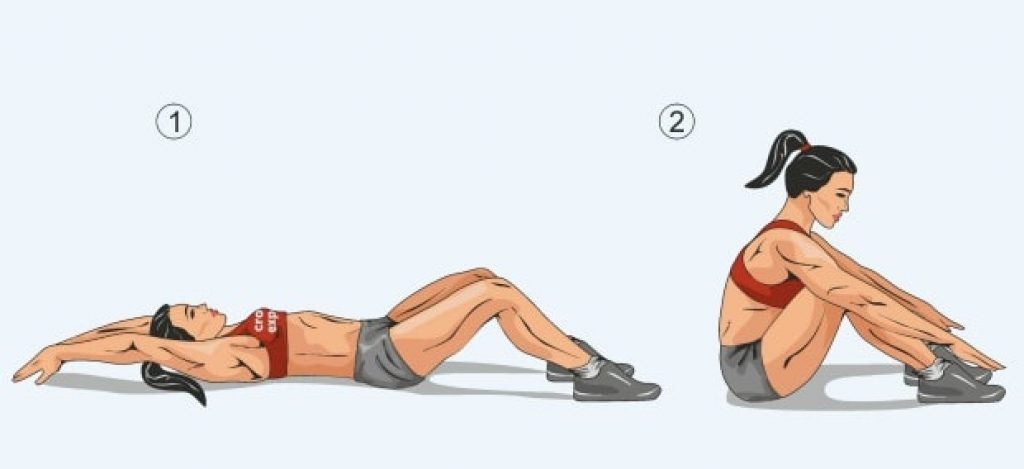
How to Do Crunches with Legs and Twists | Correct Form & Routines
How to do crunches? First of all thanks to this feature, in twisting, the lower back gets about one and a half times less compression load than when performing a fold. And while muscle activation in crunches is also significant below, exercise in perspective provides fewer risks to the back. check source
Also Read: How to do 180 Jump Squats | Correct Form & Routines
At the same time, trainers and scientists periodically think about how to make crunches on the press not only safe, but also more effective in terms of pumping muscles. Below we will list what they found. check source
How to do Abdominal Crunches to Better Load your Muscles
There are many exercise options that differ in the position of the legs and arms, range of motion, and stability of support. Based on research data, we will choose the best technique
How to put your feet
Most often, crunches on the press are performed by bending the hips at an angle of 45 ° and pressing the feet against the mat.

You can also do this exercise with your hips and knees bent at right angles. In this case, the shins can be held in weight or put on a low support – a bench or box.

A 90 ° hip curl is better loads abdominal muscles both in dynamics and in static. when you lift the body and fix the position for a while. check source
Fix Feet or Not
If you move your feet under the couch or ask someone to hold your ankles, activating the abdominal muscles will increase but at the same time will increase and compression load on the lower back.
In addition, the fixation of the legs increase activation of the hip flexors. For pre-existing back problems, this can aggravate the condition and cause pain.
Therefore, it makes sense to keep your legs free, especially if you are looking for exercise with minimal risk to the lower back. check source
Where to Keep Your Hands
Most often, twists are done with the hands behind the head, when the elbows are bent and the fingers touch the back of the head. You can also straighten your arms at the seams with your palms down, extend them behind your head, or cross them over your chest.
From a biomechanical point of view, the farther the weight (arms) is from the press, the longer the lever and the greater the load on the muscles.
In one experiment found that the position with the arms bent behind the head or extended above it increases the activation of the abdominal muscles compared to the position of the arms along the body. check source

Despite the fact that the study tested static twisting (5 seconds of hold), it is logical to assume that this will work for the dynamic version as well.
Also Read: How to Perform a Side Lunge
STEPS: How to do Crunches at Home with Legs and Twists
- Lie on your back with your hands at your sides and your legs extended.
- Raise your legs and lift your hips, turning them slightly to the left.
- Slowly lower your legs without letting them touch the floor and then repeat on the right side.
- Keep alternating sides until the game is complete.
How High to Climb Crunches
In one researched checked how high you need to rise in crunches so that the abdominal muscles are fully activated.
To find out, they used a standard abdominal strength test. Participants lay on their backs, bending their knees, and stretching their arms along the body. Then they were instructed to twist the body so that the fingers moved forward 5, 10 or 15 cm.

It turned out that the abdominal muscles tensed best when the fingers moved 10 cm forward. With this rise, the shoulder blades are completely lifted off the floor, but the lower back remains pressed.
To determine how high you need to climb, you can once measure the distance with a ruler, remember the sensations and then perform in a similar range without any measurements.
How to Breathe While Crunches
In one experiment tested how the three breathing modes affect muscle activation during twisting. Participants performed crunches either on hold (in the first variant, after a full inhalation, in the second, after a full exhalation), or with a slow exhalation at the moment of effort.
It turned out that the greatest muscle activation can be achieved using full exhalation and holding effort. check source
How Fast to Go Up and Down
Research showed that eccentric crunches on the press with a body bend of 30 ° better than others pump the transverse abdominal muscle located under the obliques and is responsible for stabilizing the body.
Try increasing the eccentric phase of the exercise – when you return your shoulder blades and shoulders to the floor. For example, go up in one second and go down in two. check source
To pump muscles to the fullest, perform the movement like this:
- Lie on the floor on your back, bend your hips and knees at right angles. You can put your shins on a support of a suitable height or leave them hanging.
- Straighten your arms over your head or place them behind your head.
- Exhale, tighten your abs and hold your breath.
- Tear your head, shoulders and shoulder blades off the floor, leave your lower back pressed against it.
- Return slowly to starting position and repeat.
What Mistakes should be Avoided When Doing the Exercise
There is some common mistakes that will prevent you from properly pumping your abs and can lead to overexertion and pain:
- Do not rest your chin against your chest. This overloads the neck and can cause pain. Imagine a tennis ball squeezed between your chin and neck.
- Do not climb high off the floor. If you lift your lower back off the floor, the twist becomes a fold, and the lower part of the spine receives more stress.
- Don’t relax your abs . From the moment you exhaled fully and tightened your abs, and until the end of the approach, you must consciously keep your stomach in tension. This will help to better load the muscles and prevent you from lifting your lower back off the floor. check source
How Often to do Crunches on the Press
The abdominal muscles are very hardy, they hardly get tired and quickly recover. Therefore, you can safely perform several sets of crunches on the press every day without fear of overloading the muscles.
Start with 3-4 sets of 20-25 reps. Over time, you can increase the number to 4-5 approaches 50 times.
But if you don’t have back problems, don’t get hung up on this exercise. For a complete pumping of the muscles of the body, it is better to alternate twisting on the press with other effective movements: “bicycle”, lifting the knees while hanging on the horizontal bar, rolling with a roller.
How to Complicate Crunches on the Press
You can make the abdominal crunches harder to tire the muscles faster.
Add resistance: Take a small 2.5 or 5 kg pancake or a dumbbell, remove the weight behind your head and do twists with it.
Watch for sensations in the neck: if you feel that it is overloaded, it is better to press the weight to your chest. And do not forget about the form of the exercise: strain the abs constantly and make sure that the lower back does not come off the floor.

What is the Correct Way to Do Leg Crunches and Twists?
Keeping your hands, head, neck, and upper back flat on the floor, engage your core muscles, and lift your legs and hips slowly one vertebra at a time.
Exhale as you lift your hips off the mat and inhale as you slowly return to the starting position.
What are the benefits of doing crunches with legs and twists?
The reverse crunch targets the abs and obliques, as well as the deep abdominal layers.
This exercise improves core and lower back stability, defines the abdominal wall, and helps slim the waist.
How many Crunches a Day and Twists should you do?
If you are a beginner, practice your reverse crunches first.
Once you are comfortable with your form, advance to the reverse twist and do 2 or 3 sets of 30 seconds to 1 minute.



